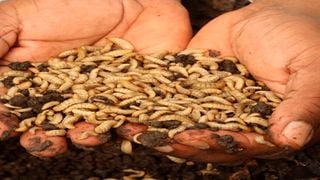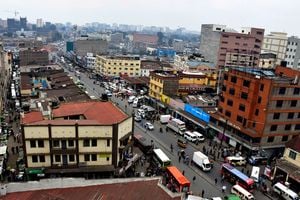
Sywan Urban Aquaculture Centre proprietor Simon Wanjohi explains how he uses market garbage to breed black soldier flies at his farm in Nyeri on May 31, 2021.
| Joseph Kanyi | Nation Media GroupSeeds of Gold
Premium
Insect rearing catches on as cost of animal feeds increases
Spread for drying on three black polythene sheets in Simon Wanjohi’s farm in Kiamwathi village in Nyeri County are dark brown insects.
Not far from the black sheets is a wire mesh placed on a raised platform, which hosts another set of insects – also drying.
Adjacent to the wire mesh structure are two greenhouses, in which the farmer keeps fish. One hosts a hatchery and the other two ponds where he keeps some 3,000 catfish.
“The fish in the greenhouses thrive because of these insects – the black soldier flies. They are the lifeline to my fish business,” says the farmer.
It’s been a week since Wanjohi harvested the produce from one of the ponds on his Sywan Urban Aquaculture Centre, which he started three years ago.

Sywan Urban Aquaculture centre proprietor Simon Wanjohi explains how he uses market garbage to breed black soldier fly at his farm in Nyeri on May 31, 2021. With him is Caroline Kendi, a intern at the farm.
The farmer sundries the insects and feeds them to the fish, what has helped him bring down the cost of production by up 50 per cent, he says.
He feeds the fish the black soldier flies larvae for four days in a week and the rest of the days he offers them pellets he formulates on the farm.
He rears the insects inside a greenhouse in tens of black crates and feeds them on rotting banana peels, oranges and avocados for the development of larvae.
“Eight kilos of the waste produce a kilo of black soldier larvae. We feed them for 10 to 12 days so that they have maximum content of crude protein of 47 to 57 per cent for our fish,” he says.
Lower production costs
Wanjohi says he embraced the insects after finding commercial feeds expensive. Also, sometimes he would end up with substandard rations. A kilo of commercial rations goes for between Sh125 and Sh200 depending on the stage of growth of the fish.
Fingerlings feeds are the most expensive.
“I have reduced my production costs by 50 per cent by using the insects. Besides, this shows the future of waste management is in fish farming. I want to solely feed the fish red worms and black soldier fly.”
Once he harvests the insects, he dips them in hot water to kill any pathogens since they feed on waste. He feeds the fish twice a day – at 10am and 4pm.
“After three to four days of sun drying, I pack them as feeds. My goal is to produce them in bulk so that I can start selling to farmers rearing fish, pigs and chickens.”
Sywan Urban Aquaculture Centre proprietor Simon Wanjohi explains how he uses market garbage to breed black soldier fly at his farm in Nyeri on May 31, 2021.
Inside the two greenhouses that sit on part of his three-quarter acres, Wanjohi rears the catfish.
“I choose catfish over tilapia because it has more flesh and few bones, what makes good fillet. Greenhouse ponds are best for rearing catfish because they thrive even during the cold season.”
Wanjohi uses the recirculation system to breed his fingerlings. This involves use of plastic tanks that host the fish at different stages of growth until they are ready for sale. “
I start selling the fingerlings when they are two inches, a length they attain at about two months. Each goes at Sh10.”
His farm produces between 10,000 and 15,000 fingerings per month. However, this is done only when the weather is favourable.
“During the cold season, it is difficult to hatch fingerlings due to the low temperatures.”
Criteria
Wanjohi, a trained social worker, identifies fish to breed (shooters) inside the pond by picking those that mature faster.
The ponds that are at least a metre deep for good quality water are subdivided into three compartments, making it easier to grade the fish.
His hatchery is inside a small greenhouse covered with a dark polythene sheet.
“Breeding the fingerlings starts with identifying mature female fish from the pond and injecting it with a hormone to hasten ripening of eggs, which are then extracted by squeezing the body.”

Simon Wanjohi explains how he rears fingerlings at his Sywan Urban Aquaculture Centre in Nyeri on May 31, 2021.
Thereafter, they take the male fish and remove the sperms by splitting it open.
"We then fertilise the eggs with the sperms and place them inside the propagation unit where temperatures should be between 28-30 degrees Celsius. After 24-36 hours, the eggs will start hatching. They start feeding after the yoke forms a fingerling," he explains.
To achieve maximum production in fish farming, he states that farmers must ensure there is quality water with the right pH.
"The environment has to be favourable for the development of fish. A farmer should ensure that there is no ammonia in the water and the pond has the right amount of oxygen,” says Wanjohi, who adds he has invested Sh2 million in the project though his initial capital was Sh500,000.
Serah Mutahi, who works with Kenya Fisheries Services, says it costs Sh243 to raise a fish to maturity.
Wanjohi says he sells a kilo at Sh450 but after value addition - filleting - it goes for Sh850. He has opened an eatery where they make fish samosas that go at Sh50 each, fish soup at Sh50 as well as prepare meals such as ugali, rice and chips with fish as an accompaniment.





